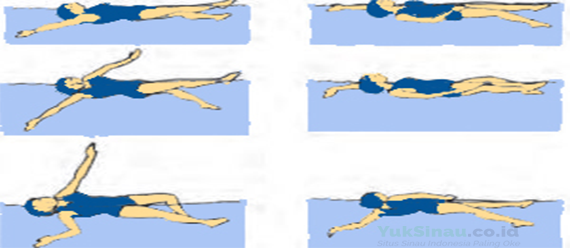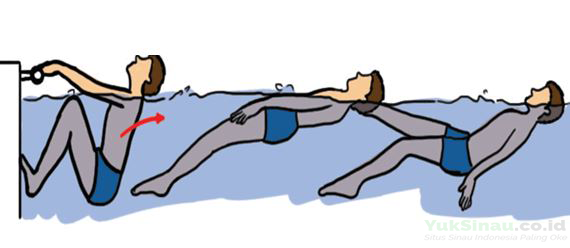Backstroke Swimming Technique
Backstroke Swimming Technique – At this time, yuksinau.co.id will explain the material about Backstroke Swimming which includes the understanding of, how to play, the rules, basic technique, examples of field images and news about sports in full.
There are different types of swimming techniques and one of the most common is the kickback technique. The backstroke technique is known as the oldest contested technique or style after the freestyle technique. The first throwback game took place at the Olympics 1900 of Paris.
The popularity of the backstroke technique in swimming has been around 1912 and at that time it was divided into 3 class in national and international competitions. In addition to the back there is also a freestyle and breaststroke. To do it right, especially if you want to be a professional swimmer, The following techniques must be mastered.
Table of Contents
What is Ranang Style Punggu?
Backstroke is a swimming style that has been known since ancient times. The back is the oldest swimming style performed after the freestyle.
Hip style is very popular around the year 1912, when swimming competitions are divided into three classes in national and international competitions, namely breaststroke, backstroke and freestyle. The force applied at that time was the basic back or back with both hands on top and the movement of frog legs or scissors legs. After the introduction of back crowd style, other forms of back style, who is not a back crowd, gradually disappearing from the swimming competition.
Techniques of Backstroke Swimming

[su_box title=”Backstroke Swimming” box_color=”#198157″]
Slide Technology
When moving your back, gliding is characteristic because the body is in a supine position in this position and is pointed upwards so that the body remains afloat and does not sink. Even when sliding, we can breathe a sigh of relief through that movement.
Practice Slides:
- Both hands holding on to the edge of the pool, the distance from the right hand to the left shoulder is shoulder width
- Both legs are folded or bent so that the soles of the feet rest on the pelvic wall with great force, both knees are between the arms
- Both hands let go of the grip on the edge of the pool, head stretched back, and with this movement both legs are pressed firmly against the wall of the pool, push the body back.
- Face remains on the surface of the water and arms at the sides of the body
- This exercise is often done so that students can glide well on their backs.
Preparation phase:
- Both arms float on the back next to the body
- Pull your thumb up on your side
- Thumb touches upper shoulder
- Turn your wrist beyond the implementation stage
- Spread your arms and open
- Keep your arms straight and at shoulder height.
- Advanced level
- Both arms are attached to the sides of the body, relax body while feeling glide. In the learning phase, use the float while gliding and hold the float just above your head with both hands
- Try to glide without a float by standing on the edge of the pool facing the pool wall and pushing both feet on the floor back and hands back..
Foot movements
This has become a trending topic lately and has gone viral in various media, the movement of the legs during the backstroke is the same as the movement of the legs during freestyle swimming, but the movement of the legs during the backstroke is performed in the supine position. Swimmers can do leg exercises with their back and hands above their heads. Backstroke starts when the race from the pool ends.
The following technique is the movement of the legs on the back of the gauya:
- Enter the pool and stand with your back to the pool wall.
- Both arms are bent so that the hands can hold the end of the pool.
- When there is a signal, the swimmer raises his legs together with his body to the surface of the water. Until the body and legs are lying on the surface of the water.
- With a "Yes" signal, The swimmer alternately moves his legs up and down.
- Leg movement starts at the groin, knees slightly bent and ending with the tips of the toes. The movement must be weak and not stiff, but should be up rather than down.
Forms of leg movement exercises
- Do leg movements while sitting
- Perform leg movements while stretching both side arms
- Practice your footwork with the launch pad
- Move your feet while holding the end of the pool.
Arm Movement
The arm movement technique is divided into three phases, i.e. tensile phase, pressure phase and resting phase. The following explanation:
- Interesting phase – The pulling movement begins after the palm is a few centimeters from the surface of the water to the maximum point where the elbow is bent or the palm is outside the shoulder.
- Push phase – thrust movement starts at the end of the turn, hands move back and forth in a quarter circle motion.
- Rest phase – The rest movement begins with the hands out of the water, with the thumb out first. After the hands are on the shoulders (arms perpendicular to the shoulders), hand outstretched and enter the surface of the water with the little finger first. This rest process must be done with rhythmic relaxation by moving the, attract, and push the arm.
Basic technique of arm movement:
- Connect one end of the foot to the handlebar by the pool, the other leg leans slightly against the pool wall to give body strength.
- supine position, face with chin slightly pulled up and arms at the sides. Swing your arms alternately
- Alternately swing your arms straight into the water on the surface of the water outside your head and with your hands beside your head.
- After the hand enters the water, pull on it and press hard on the water until the arms at the sides of the body are straight. For better results, fingers must be pressed together.
Arm exercises on land
- Practice your arm movements while standing in the water
- Practice your arm movements with the float on your stomach
Amazing Movement
Swimmer can breathe continuously during back movement. Backstroke means breathing calmly from one arm and exhaling quietly from the other.
Movement coordination
Coordination training for backstroke is an integrated exercise of all elements of back movement, which starts with a sliding motion and carefully continues with the foot movement, arm, and breathing so that the correct back can be realized.
Start Backstroke
Start Backstroke is done by leaning on your back and doing somersaults accompanied by movements of the hands and feet. Start is performed by all the swimmers lined up against the wall in the water and holding the start handle.
The backstroke swimming technique is as follows:
- The position of the hands and feet depends on the start.
- Pull your arm against the wall, then hold your head back
- Equivalent to leg push, both hands swing and head up
- Open arms to the side
- After pushing the feet, both arms must be straight.
- When the body penetrates the surface of the water, immediately bend the body until the position of the body ripples under the surface of the water.
Reverse Backstroke
Swimming on the back is done with a half somersault. The swing back technique is:
- Left hand touches the pelvic wall, knees bent and pulled
- With the help of hand pulling, the knee is directed to the arm that rests on the pelvic wall
- The paddle arms and knee pulls that form a half somersault bring both arms to the pool wall
- When they reach both hands on the pool wall, both hands reach above the head
- Perform simultaneous push-ups on the legs by stretching both arms
- Simultaneous repulsion of the legs by extending the arms and body from the pelvic wall
[/su_box]
This is how this discussion is about Backstroke Swimming Technique. And Don't Forget to Keep Visiting yuksinau.co.id because many articles are interesting and useful. Thank you for being loyal with us and still sinau all my friends.
Also Read Other Interesting Articles :
- Breaststroke Swimming Technique
- Freestyle Swimming Techniques
- Basic Pole Jumping Techniques
- Basic Infectious Jumping Techniques
- Basic High Jump Technique
- Basic Long Jump Techniques
The post Backstroke Swimming Technique appeared first on YukSinau.co.id.
